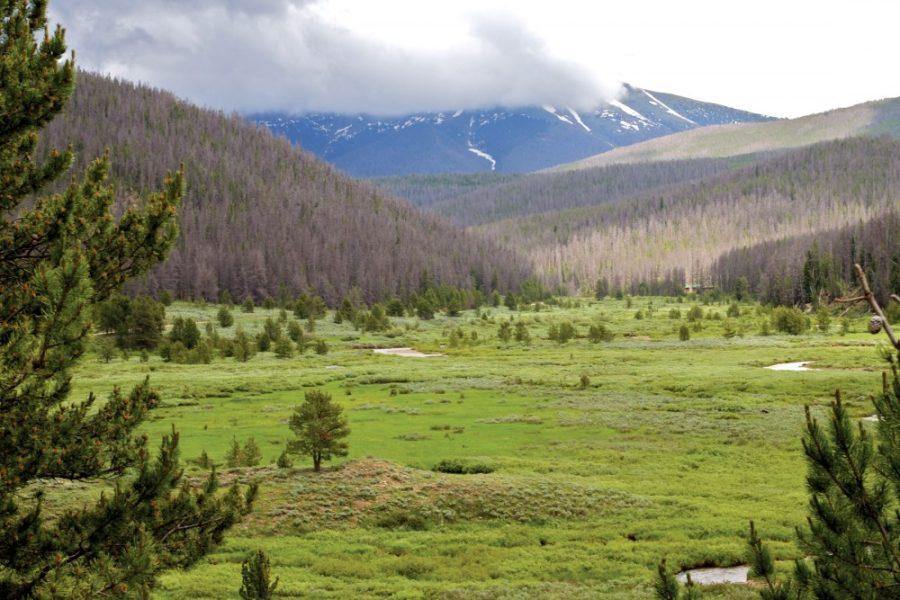A fallen spruce tree decays beneath the dense canopy of its neighbors—another victim of the ruthless invaders of the forests of southeastern Arizona.
Hundreds of thousands of these invaders penetrate the protective bark of vulnerable trees to reach the desirable phloem: a section of the tree between the bark and growth rings that contains the highest nutrient content and best-quality sugars.
This time, the beetles won.
The spruce beetle (Dendroctonus rufipennis) is one of the biggest threats to the spruce-fir forest ecosystems within the Pinaleño Mountains of the Sky Island region, which extends from northern Mexico to Southern Arizona and includes parts of New Mexico.
The Sky Islands’ name originates from the appearance, when looking down on the region from space, of isolated mountains among a sea of flat desert. This type of forest is only found in high elevations above 7,000 feet with at least 14.24 inches of rain per year.
During the past decade, higher summer temperatures and less spring rain have stressed the region’s ecosystem. These climate stressors are allowing naturally occurring cycles, such as wildfires and beetle outbreaks, to be deadly for the trees.
A hundred years of fire exclusion, or wildfire suppression by various governmental organizations, have also expanded the range of available hosts for the spruce beetles, creating denser forests with a greater potential for destructive fires.
If nothing is done to stop the demise of these forests, then certain plant and animal species might not have a future in the Sky Island region.
Beetles attack
Kit O’Connor, a research associate for the UA School of Natural Resources and the Environment with a background in entomology, researched the severity and size of the beetle outbreaks using dendrochronology, or tree-ring dating, and other methods in the Pinaleño Mountains.
His findings revealed that fire exclusion and climate factors were intensifying the beetle infestations.
Beetles need a thick forest of stressed, mature trees to be successful in their daily activities.
The exclusion of fire from mixed conifer and spruce-fir forests allowed fuel to build up and denser forests to develop, creating ideal conditions for spruce beetles.
Tree-ring scars date the previous damage done by failed beetle outbreaks. Yet, high-stress factors caused by climate change, such as higher temperature or competition for resources like water or sunlight, make the trees more susceptible to spruce beetles and other invaders of the forest.
“Basically, their immune systems get compromised,” O’Connor said.
Then, the process is simple. A beetle locates a weak tree, burrows into the phloem and uses pheromones, a type of chemical communication, to inform its friends of the find.
“It is mind-boggling to imagine these [small beetles] could ever cause damage to a tree,” O’Connor said.
After the harshest outbreak in the last 50 years ended in 2002, there was only 15 percent of the host material, or trees in an ideal state for attack, left in the Pinaleños.
This is good and bad; spruce beetles need a large dense forest to spread, so a severe outbreak will probably not occur in the near future. On the other hand, the once-beautiful spruce-fir ecosystem in the Pinaleños is now teetering on the edge of existence.
Up in flames
The ideal conditions for beetle outbreaks are similar to the ones contributing to the increase of Southwestern wildfires in the last five years. High temperatures and drought lengthen the fire season, which begins in early spring and extends into the fall.
Fire exclusion created denser forests and shifted different types of forest into the same region, mixing fire-tolerant and non-tolerant species together.
This change in boundaries is damaging both types of forest ecosystems. Trees cannot endure their natural fire cycles, allowing for more destructive fires.
These large fires increase carbon dioxide emissions with the burning of live trees, damage human properties and eliminate habitat for other plant and animal species. There is limited funding to prevent the disasters—only money to protect important properties once the fires begin.
This problem affects the whole Southwestern U.S., including Tucson.
Actions taken
The nonprofit Sky Island Alliance promotes smart land-management polices and conservational work in the ever-changing climate. The organization also plans volunteer field projects within the region to restore ecosystem services, lost habitat and species diversity.
“[You] feel an immediate sense of accomplishment after volunteer work,” said conservation director Louise Misztal.
Land management agencies such as the U.S. Forest Service are “thinking across boundaries,” Misztal said. Instead of trying to solve the problems on their own, some of the agencies are working together to look at a bigger picture of the region.
Actions have also been taken by the Coronado National Forest to restore damaged areas and prevent future events. For example, forest thinning and controlled burns are among the progressive ideas on the agency’s list to prevent outbreaks and fires.
The victims of the beetle attacks and wildfires are the driving force behind this environmental change. There is hope that this new era of land management will protect threatened plant and animal species in the Sky Islands and other parts of the Southwest.
Follow Kaitlyn Fletcher on Twitter.









